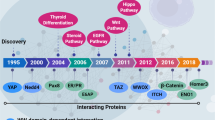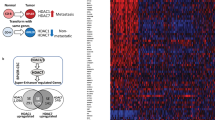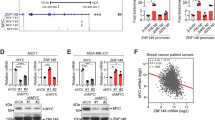Abstract
Protein phosphatase 2A (PP2A) is a critical human tumor-suppressor complex. A recently characterized PP2A inhibitor protein, namely cancerous inhibitor of PP2A (CIP2A), has been found to be overexpressed at a high frequency in most of the human cancer types. However, our understanding of gene expression programs regulated by CIP2A is almost absent. Moreover, clinical relevance of the CIP2A-regulated transcriptome has not been addressed thus far. Here, we report a high-confidence transcriptional signature regulated by CIP2A. Bioinformatic pathway analysis of the CIP2A signature revealed that CIP2A regulates several MYC-dependent and MYC-independent gene programs. With regard to MYC-independent signaling, JNK2 expression and transwell migration were inhibited by CIP2A depletion, whereas MYC depletion did not affect either of these phenotypes. Instead, depletion of either CIP2A or MYC inhibited cancer cell colony growth with statistically indistinguishable efficiency. Moreover, CIP2A depletion was shown to regulate the expression of several established MYC target genes, out of which most were MYC-repressed genes. CIP2A small-interfering RNA-elicited inhibition of colony growth or activation of MYC-repressed genes was reversed at large by concomitant PP2A inhibition. Finally, the CIP2A signature was shown to cluster with basal-type and human epidermal growth factor receptor (HER)2-positive (HER2+) breast cancer signatures. Accordingly, CIP2A protein expression was significantly associated with basal-like (P=0.0014) and HER2+ (P<0.0001) breast cancers. CIP2A expression also associated with MYC gene amplification (P<0.001). Taken together, identification of CIP2A-driven transcriptional signature, and especially novel MYC-independent signaling programs regulated by CIP2A, provides important resource for understanding CIP2A's role as a clinically relevant human oncoprotein. With regard to MYC, these results both validate CIP2A’s role in regulating MYC-mediated gene expression and provide a plausible novel explanation for the high MYC activity in basal-like and HER2+ breast cancers.
This is a preview of subscription content, access via your institution
Access options
Subscribe to this journal
Receive 50 print issues and online access
$259.00 per year
only $5.18 per issue
Buy this article
- Purchase on Springer Link
- Instant access to full article PDF
Prices may be subject to local taxes which are calculated during checkout






Similar content being viewed by others
References
Alles MC, Gardiner-Garden M, Nott DJ, Wang Y, Foekens JA, Sutherland RL et al. (2009). Meta-analysis and gene set enrichment relative to ER status reveal elevated activity of MYC and E2F in the ‘basal’ breast cancer subgroup. PLoS One 4: e4710.
Arnold HK, Sears RC . (2006). Protein phosphatase 2A regulatory subunit B56alpha associates with c-myc and negatively regulates c-myc accumulation. Mol Cell Biol 26: 2832–2844.
Ben-Israel H, Sharf R, Rechavi G, Kleinberger T . (2008). Adenovirus E4orf4 protein downregulates MYC expression through interaction with the PP2A-B55 subunit. J Virol 82: 9381–9388.
Bolstad BM, Irizarry RA, Astrand M, Speed TP . (2003). A comparison of normalization methods for high density oligonucleotide array data based on variance and bias. Bioinformatics 19: 185–193.
Cappellen D, Schlange T, Bauer M, Maurer F, Hynes NE . (2007). Novel c-MYC target genes mediate differential effects on cell proliferation and migration. EMBO Rep 8: 70–76.
Chandriani S, Frengen E, Cowling VH, Pendergrass SA, Perou CM, Whitfield ML et al. (2009). A core MYC gene expression signature is prominent in basal-like breast cancer but only partially overlaps the core serum response. PLoS One 4: e6693.
Chen KF, Liu CY, Lin YC, Yu HC, Liu TH, Hou DR et al. (2010). CIP2A mediates effects of bortezomib on phospho-Akt and apoptosis in hepatocellular carcinoma cells. Oncogene 29: 6257–6266.
Chen W, Possemato R, Campbell KT, Plattner CA, Pallas DC, Hahn WC . (2004). Identification of specific PP2A complexes involved in human cell transformation. Cancer Cell 5: 127–136.
Choi YA, Park JS, Park MY, Oh KS, Lee MS, Lim JS et al. (2011). Increase in CIP2A expression is associated with doxorubicin resistance. FEBS Lett 585: 755–760.
Come C, Laine A, Chanrion M, Edgren H, Mattila E, Liu X et al. (2009). CIP2A is associated with human breast cancer aggressivity. Clin Cancer Res 15: 5092–5100.
Dai M, Wang P, Boyd AD, Kostov G, Athey B, Jones EG et al. (2005). Evolving gene/transcript definitions significantly alter the interpretation of GeneChip data. Nucleic Acids Res 33: e175.
Deming SL, Nass SJ, Dickson RB, Trock BJ . (2000). C-myc amplification in breast cancer: a meta-analysis of its occurrence and prognostic relevance. Br J Cancer 83: 1688–1695.
Dong QZ, Wang Y, Dong XJ, Li ZX, Tang ZP, Cui QZ et al. (2010). CIP2A is overexpressed in non-small cell lung cancer and correlates with poor prognosis. Ann Surg Oncol 18: 857–865.
Eichhorn PJ, Creyghton MP, Bernards R . (2009). Protein phosphatase 2A regulatory subunits and cancer. Biochim Biophys Acta 1795: 1–15.
Enerly E, Steinfeld I, Kleivi K, Leivonen SK, Aure MR, Russnes HG et al. (2011). miRNA-mRNA integrated analysis reveals roles for miRNAs in primary breast tumors. PLoS One 6: e16915.
Fernandez PC, Frank SR, Wang L, Schroeder M, Liu S, Greene J et al. (2003). Genomic targets of the human c-Myc protein. Genes Dev 17: 1115–1129.
Gentleman RC, Carey VJ, Bates DM, Bolstad B, Dettling M, Dudoit S et al. (2004). Bioconductor: open software development for computational biology and bioinformatics. Genome Biol 5: R80.
Guenebeaud C, Goldschneider D, Castets M, Guix C, Chazot G, Delloye-Bourgeois C et al. (2010). The dependence receptor UNC5H2/B triggers apoptosis via PP2A-mediated dephosphorylation of DAP kinase. Mol Cell 40: 863–876.
Hahn WC, Counter CM, Lundberg AS, Beijersbergen RL, Brooks MW, Weinberg RA . (1999). Creation of human tumour cells with defined genetic elements. Nature 400: 464–468.
Ioannidis JP, Allison DB, Ball CA, Coulibaly I, Cui X, Culhane AC et al. (2009). Repeatability of published microarray gene expression analyses. Nat Genet 41: 149–155.
Janssens V, Longin S, Goris J . (2008). PP2A holoenzyme assembly: in cauda venenum (the sting is in the tail). Trends Biochem Sci 33: 113–121.
Joensuu H, Isola J, Lundin M, Salminen T, Holli K, Kataja V et al. (2003). Amplification of erbB2 and erbB2 expression are superior to estrogen receptor status as risk factors for distant recurrence in pT1N0M0 breast cancer: a nationwide population-based study. Clin Cancer Res 9: 923–930.
Junttila MR, Puustinen P, Niemela M, Ahola R, Arnold H, Bottzauw T et al. (2007). CIP2A inhibits PP2A in human malignancies. Cell 130: 51–62.
Katz J, Jakymiw A, Ducksworth MK, Stewart CM, Bhattacharyya I, Cha S et al. (2010). CIP2A expression and localization in oral carcinoma and dysplasia. Cancer Biol Ther 10: 694–699.
Khanna A, Bockelman C, Hemmes A, Junttila MR, Wiksten JP, Lundin M et al. (2009). MYC-dependent regulation and prognostic role of CIP2A in gastric cancer. J Natl Cancer Inst 101: 793–805.
Li W, Ge Z, Liu C, Liu Z, Bjorkholm M, Jia J et al. (2008). CIP2A is overexpressed in gastric cancer and its depletion leads to impaired clonogenicity, senescence, or differentiation of tumor cells. Clin Cancer Res 14: 3722–3728.
Li Z, Van Calcar S, Qu C, Cavenee WK, Zhang MQ, Ren B . (2003). A global transcriptional regulatory role for c-Myc in Burkitt's lymphoma cells. Proc Natl Acad Sci USA 100: 8164–8169.
Lin SM, Du P, Huber W, Kibbe WA . (2008). Model-based variance-stabilizing transformation for Illumina microarray data. Nucleic Acids Res 36: e11.
Mathiasen DP, Egebjerg C, Andersen SH, Rafn B, Puustinen P, Khanna A et al. (2011). Identification of a c-Jun N-terminal kinase-2-dependent signal amplification cascade that regulates c-Myc levels in ras transformation. Oncogene (e-pub ahead of print 27 June 2011; doi:10.1038/onc.2011.230).
Mannava S, Omilian AR, Wawrzyniak JA, Fink EE, Zhuang D, Miecznikowski JC et al. (2011). PP2A-B56α controls oncogene-induced senescence in normal and tumor human melanocytic cells. Oncogene (e-pub ahead of print 8 August 2011; doi:10.1038/onc.2011.339).
Meyer N, Penn LZ . (2008). Reflecting on 25 years with MYC. Nat Rev Cancer 8: 976–990.
Miller LD, Smeds J, George J, Vega VB, Vergara L, Ploner A et al. (2005). An expression signature for p53 status in human breast cancer predicts mutation status, transcriptional effects, and patient survival. Proc Natl Acad Sci USA 102: 13550–13555.
Mumby M . (2007). PP2A: unveiling a reluctant tumor suppressor. Cell 130: 21–24.
Qu W, Li W, Wei L, Xing L, Wang X, Yu J . (2010). CIP2A is overexpressed in esophageal squamous cell carcinoma. Med Oncol (e-pub ahead of print).
Rangarajan A, Hong SJ, Gifford A, Weinberg RA . (2004). Species- and cell type-specific requirements for cellular transformation. Cancer Cell 6: 171–183.
Sablina AA, Hector M, Colpaert N, Hahn WC . (2010). Identification of PP2A complexes and pathways involved in cell transformation. Cancer Res 70: 10474–10484.
Sihto H, Lundin J, Lehtimaki T, Sarlomo-Rikala M, Butzow R, Holli K et al. (2008). Molecular subtypes of breast cancers detected in mammography screening and outside of screening. Clin Cancer Res 14: 4103–4110.
Soo Hoo L, Zhang JY, Chan EK . (2002). Cloning and characterization of a novel 90 kDa ‘companion, auto-antigen of p62 overexpressed in cancer. Oncogene 21: 5006–5015.
Vaarala MH, Vaisanen MR, Ristimaki A . (2010). CIP2A expression is increased in prostate cancer. J Exp Clin Cancer Res 29: 136.
Virshup DM, Shenolikar S . (2009). From promiscuity to precision: protein phosphatases get a makeover. Mol Cell 33: 537–545.
Westermarck J, Hahn WC . (2008). Multiple pathways regulated by the tumor suppressor PP2A in transformation. Trends Mol Med 14: 152–160.
Xu J, Chen Y, Olopade OI . (2010). MYC and breast cancer. Genes Cancer 1: 629–640.
Zhao JJ, Roberts TM, Hahn WC . (2004). Functional genetics and experimental models of human cancer. Trends Mol Med 10: 344–350.
Acknowledgements
We thank Taina Kalevo-Mattila for expert technical assistance. Melissa R Junttila is acknowledged for PP2A assay data and Minna-Maija Lintunen for performing the FISH hybridizations. Panu Jaakkola is acknowledged for B-subunit siRNAs. The Finnish DNA Microarray centre is acknowledged for the microarray and qRT–PCR analysis. This study was supported by grants from the Academy of Finland (grant no. 125826, 1131449 and 8217676), Sigrid Juselius Foundation, the Cancer Society of Finland, Helsinki University Central Hospital Research Funds (TYH2009304) and the Foundation of Finnish Cancer Institute.
Author information
Authors and Affiliations
Corresponding author
Ethics declarations
Competing interests
The authors declare no conflict of interest.
Additional information
Supplementary Information accompanies the paper on the Oncogene website
Supplementary information
Rights and permissions
About this article
Cite this article
Niemelä, M., Kauko, O., Sihto, H. et al. CIP2A signature reveals the MYC dependency of CIP2A-regulated phenotypes and its clinical association with breast cancer subtypes. Oncogene 31, 4266–4278 (2012). https://doi.org/10.1038/onc.2011.599
Received:
Revised:
Accepted:
Published:
Issue Date:
DOI: https://doi.org/10.1038/onc.2011.599
Keywords
This article is cited by
-
CIP2A silencing alleviates doxorubicin resistance in MCF7/ADR cells through activating PP2A and autophagy
Clinical and Translational Oncology (2021)
-
Mission Possible: Advances in MYC Therapeutic Targeting in Cancer
BioDrugs (2019)
-
Cip2a promotes cell cycle progression in triple-negative breast cancer cells by regulating the expression and nuclear export of p27Kip1
Oncogene (2017)
-
CIP2A is associated with multidrug resistance in cervical adenocarcinoma by a P-glycoprotein pathway
Tumor Biology (2016)
-
Deregulation of the protein phosphatase 2A, PP2A in cancer: complexity and therapeutic options
Tumor Biology (2016)



